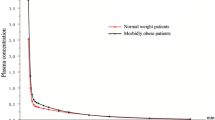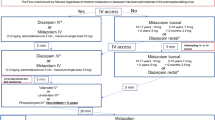Abstract
Background and Objective
Given the alarming increase in obesity among children undergoing surgery, the main aim of this study was to characterize propofol clearance in a cohort of morbidly obese children and adolescents in relation to their age and body weight characteristics.
Methods
A prospective pharmacokinetic study in morbidly obese children and adolescents undergoing elective surgery was conducted. Serial blood samples were collected and nonlinear mixed-effects modelling using NONMEM® was performed to characterize propofol pharmacokinetics with subsequent evaluation of age and body size descriptors.
Results
Twenty obese and morbidly obese children and adolescents with a mean age of 16 years (range 9–18 years), a mean total body weight (TBW) of 125 kg (range 70–184 kg) and a mean body mass index of 46kg/m2 (range 31–63 kg/m2) were available for pharmacokinetic modelling using a two-compartment pharmacokinetic model (n = 294 propofol concentration measurements). Compared with lean body weight and ideal body weight, TBW proved to be the most predictive covariate for clearance [CL (L/min)= 1.70 × (TBW/70)0.8]. Central volume of distribution, peripheral volume and intercompartmental clearance were 45.2 L, 128 L and 1.75 L/min, respectively, with no predictive covariates identifiable.
Conclusion
In the population pharmacokinetic model for propofol in morbidly obese children and adolescents, TBW proved to be the most significant determinant for clearance. As a result, it is anticipated that dosage of propofol for maintenance of anaesthesia in morbidly obese children and adolescents should be based on TBW using an allometric function.
Trial registration number (clinicaltrials.gov)
NCT00948597







Similar content being viewed by others
References
Ogden CL, Carroll MD, Curtin LR, et al. Prevalence of high body mass index in US children and adolescents, 2007–2008. JAMA 2010 Jan 20; 303(3): 242–9
Skelton JA, Cook SR, Auinger P, et al. Prevalence and trends of severe obesity among US children and adolescents. Acad Pediatr 2009 Sep–Oct; 9(5): 322–9
Ingelfinger JR. Bariatric surgery in adolescents. N Engl J Med 2011 Oct 13; 365(15): 1365–7
Mulla H, Johnson TN. Dosing dilemmas in obese children. Arch Dis Child Educ Pract Ed 2010 Aug; 95(4): 112–7
Schuttler J, Ihmsen H. Population pharmacokinetics of propofol: a multicenter study. Anesthesiology 2000 Mar; 92(3): 727–38
Shafer A, Doze VA, Shafer SL, et al. Pharmacokinetics and pharmaco-dynamics of propofol infusions during general anesthesia. Anesthesiology 1988 Sep; 69(3): 348–56
Kataria BK, Ved SA, Nicodemus HF, et al. The pharmacokinetics of propofol in children using three different data analysis approaches. Anesthesiology 1994 Jan; 80(1): 104–22
Jones RD, Chan K, Andrew LJ. Pharmacokinetics of propofol in children. Br J Anaesth 1990 Nov; 65(5): 661–7
Peeters MY, Prins SA, Knibbe CA, et al. Propofol pharmacokinetics and pharmacodynamics for depth of sedation in nonventilated infants after major craniofacial surgery. Anesthesiology 2006 Mar; 104(3): 466–74
Rigby-Jones AE, Sneyd JR. Propofol and children: what we know and what we do not know. Paediatr Anaesth 2011 Mar; 21(3): 247–54
Servin F, Farinotti R, Haberer JP, et al. Propofol infusion for maintenance of anesthesia in morbidly obese patients receiving nitrous oxide: a clinical and pharmacokinetic study. Anesthesiology 1993 Apr; 78(4): 657–65
Cortinez LI, Anderson BJ, Penna A, et al. Influence of obesity on propofol pharmacokinetics: derivation of a pharmacokinetic model. Br J Anaesth 2010 Oct; 105(4): 448–56
van Kralingen S, Diepstraten J, Peeters MY, et al. Population pharmacokinetics and pharmacodynamics of propofol in morbidly obese patients. Clin Pharmacokinet 2011 Nov 1; 50(11): 739–50
Janmahasatian S, Duffull SB, Ash S, et al. Quantification of lean bodyweight. Clin Pharmacokinet 2005; 44(10): 1051–65
Peters AM, Snelling HL, Glass DM, et al. Estimation of lean body mass in children. Br J Anaesth 2011 May; 106(5): 719–23
Development of PK/PD model for individualized propofol dosing [Clinical-Trials.gov identifier NCT00948597]. US National Institutes of Health, ClinicalTrials.gov [online]. Available from URL: http://www.clinicaltrails.gov [Accessed 2012 May 10]
Peeters MY, Prins SA, Knibbe CA, et al. Pharmacokinetics and pharmacodynamics of midazolam and metabolites in nonventilated infants after craniofacial surgery. Anesthesiology 2006 Dec; 105(6): 1135–46
Barlow SE. Expert committee recommendations regarding the prevention, assessment, and treatment of child and adolescent overweight and obesity: summary report. Pediatrics 2007 Dec; 120 Suppl. 4: S164–92
Knibbe CA, Koster VS, Deneer VH, et al. Determination of propofol in low-volume samples by high-performance liquid chromatography with fluorescence detection. J Chromatogr B Biomed Sci Appl 1998 Mar 20; 706(2): 305–10
Yeganeh MH, Ramzan I. Determination of propofol in rat whole blood and plasma by high-performance liquid chromatography. J Chromatogr B Biomed Sci Appl 1997 Apr 11; 691(2): 478–82
Beal SL, Sheiner LB, Boeckmann A. NONMEM user’s guide. San Francisco (CA): University of California, 1999
Pai MP, Paloucek FP. The origin of the “ideal” body weight equations. Ann Pharmacother 2000 Sep; 34(9): 1066–9
Anderson BJ, Holford NH. Mechanistic basis of using body size and maturation to predict clearance in humans. Drug Metab Pharmacokinet 2009; 24(1): 25–36
McLeay SC, Morrish GA, Kirkpatrick CM, et al. Encouraging the move towards predictive population models for the obese using propofol as a motivating example. Pharm Res 2009 Jul; 26(7): 1626–34
Mahmood I. Application of fixed exponent 0.75 to the prediction of human drug clearance: an inaccurate and misleading concept. Drug Metabol Drug Interact 2009; 24(1): 57–81
Mahmood I. Evaluation of a morphine maturation model for the prediction of morphine clearance in children: how accurate is the predictive performance of the model? Br J Clin Pharmacol 2011 Jan; 71(1): 88–94
Krekels EH, DeJongh J, van Lingen RA, et al. Predictive performance of a recently developed population pharmacokinetic model for morphine and its metabolites in new datasets of (preterm) neonates, infants and children. Clin Pharmacokinet 2011 Jan 1; 50(1): 51–63
Marsh B, White M, Morton N, et al. Pharmacokinetic model driven infusion of propofol in children. Br J Anaesth 1991 Jul; 67(1): 41–8
Eleveld DJ, Proost JH, Absalom AR, et al. Obesity and allometric scaling of pharmacokinetics. Clin Pharmacokinet 2011 Nov 1; 50(11): 751–3
Coppens MJ, Eleveld DJ, Proost JH, et al. An evaluation of using population pharmacokinetic models to estimate pharmacodynamic parameters for propofol and bispectral index in children. Anesthesiology 2011 Jul; 115(1): 83–93
Acknowledgements
We would like to acknowledge the Teen Longitudinal Assessment of Bariatric Surgery team at Cincinnati Children’s Hospital Medical Center (www.Teen-LABS.org) for their support during this study. This study was funded by the Translational Research Initiative grant from Cincinnati Children’s Research Foundation, Cincinnati Children’s Hospital Medical Center, Cincinnati, OH, USA. We would like to acknowledge financial support from NIH grant 1K24HD050387 (AAV). We also acknowledge the work of Elke H.J. Krekels, MSc during manuscript preparation.
The authors have indicated they have no financial relationships relevant to this article to disclose. The authors have no conflicts of interest that are directly relevant to the content of this study.
Author information
Authors and Affiliations
Corresponding author
Rights and permissions
About this article
Cite this article
Diepstraten, J., Chidambaran, V., Sadhasivam, S. et al. Propofol Clearance in Morbidly Obese Children and Adolescents. Clin Pharmacokinet 51, 543–551 (2012). https://doi.org/10.1007/BF03261930
Published:
Issue Date:
DOI: https://doi.org/10.1007/BF03261930




